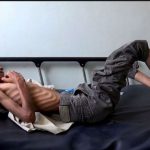A U.N.-backed report on Yemen has found no full-blown famine in the country but said 60 percent of Yemenis, or 17 million people, are in “crisis” or “emergency” food situations, 20 percent more than in June.
The World Food Programme said in a statement on Wednesday that the governorates of Taiz and Hodeidah along the Red Sea risked slipping into famine if they did not receive more aid. Both have long traditions as food-producing regions.
The crisis follows two years of civil war pitting the Iran-allied Houthi group against a Saudi-backed coalition, which has caused economic collapse and severely restricted the food and fuel imports on which Yemen depends.
“If humanitarian actors do not access all the people in need by the coming months, the situation may deteriorate dramatically,” the report said.
Taiz and Hodeidah governorates, home to important Yemeni ports, “have the highest rates of global acute malnutrition in the country, ranging from 17 percent in Taiz City to 25 percent in Hodeidah,” the WFP said.
“The emergency threshold set by the World Health Organization is 15 percent,” it added.
The report was written by an expert team using the globally recognised IPC methodology. The IPC, or Integrated Food Security Phase Classification, is a system of analysing food security on a five-point scale, where five is “famine”.
The report, drawing on analysis from 69 experts from Yemen’s government and regions, the United Nations and non-governmental institutions, said 10.2 million people were at phase three, or “crisis”, and 6.8 million at phase four, or “emergency”.
The worst affected governorates – those in the emergency phase – were Lahej, Taiz, Abyan, Sa’ada, Hajjah, Hodeidah and Shabwah, it said. Taiz, where heavy fighting looks likely to continue, has seen its biggest spike in livestock and commodity prices since the war escalated in 2015.
Yemen is one of four current famine or near-famine situations, along with South Sudan, northeast Nigeria and Somalia, with more than 20 million people at risk of starvation in the next six months.
Last month the U.N. said more than $4 billion was needed by the end of March to stave off starvation in the four countries on the brink of starvation.
U.N. officials say that once a famine is officially declared, it is usually too late because large numbers of people have already died.
A U.N.-backed report on Yemen has found no full-blown famine in the country but said 60 percent of Yemenis, or 17 million people, are in “crisis” or “emergency” food situations, 20 percent more than in June.
The World Food Programme said in a statement on Wednesday that the governorates of Taiz and Hodeidah along the Red Sea risked slipping into famine if they did not receive more aid. Both have long traditions as food-producing regions.
The crisis follows two years of civil war pitting the Iran-allied Houthi group against a Saudi-backed coalition, which has caused economic collapse and severely restricted the food and fuel imports on which Yemen depends.
“If humanitarian actors do not access all the people in need by the coming months, the situation may deteriorate dramatically,” the report said.
Taiz and Hodeidah governorates, home to important Yemeni ports, “have the highest rates of global acute malnutrition in the country, ranging from 17 percent in Taiz City to 25 percent in Hodeidah,” the WFP said.
“The emergency threshold set by the World Health Organization is 15 percent,” it added.
The report was written by an expert team using the globally recognised IPC methodology. The IPC, or Integrated Food Security Phase Classification, is a system of analysing food security on a five-point scale, where five is “famine”.
The report, drawing on analysis from 69 experts from Yemen’s government and regions, the United Nations and non-governmental institutions, said 10.2 million people were at phase three, or “crisis”, and 6.8 million at phase four, or “emergency”.
The worst affected governorates – those in the emergency phase – were Lahej, Taiz, Abyan, Sa’ada, Hajjah, Hodeidah and Shabwah, it said. Taiz, where heavy fighting looks likely to continue, has seen its biggest spike in livestock and commodity prices since the war escalated in 2015.
Yemen is one of four current famine or near-famine situations, along with South Sudan, northeast Nigeria and Somalia, with more than 20 million people at risk of starvation in the next six months.
Last month the U.N. said more than $4 billion was needed by the end of March to stave off starvation in the four countries on the brink of starvation.
U.N. officials say that once a famine is officially declared, it is usually too late because large numbers of people have already died.
A U.N.-backed report on Yemen has found no full-blown famine in the country but said 60 percent of Yemenis, or 17 million people, are in “crisis” or “emergency” food situations, 20 percent more than in June.
The World Food Programme said in a statement on Wednesday that the governorates of Taiz and Hodeidah along the Red Sea risked slipping into famine if they did not receive more aid. Both have long traditions as food-producing regions.
The crisis follows two years of civil war pitting the Iran-allied Houthi group against a Saudi-backed coalition, which has caused economic collapse and severely restricted the food and fuel imports on which Yemen depends.
“If humanitarian actors do not access all the people in need by the coming months, the situation may deteriorate dramatically,” the report said.
Taiz and Hodeidah governorates, home to important Yemeni ports, “have the highest rates of global acute malnutrition in the country, ranging from 17 percent in Taiz City to 25 percent in Hodeidah,” the WFP said.
“The emergency threshold set by the World Health Organization is 15 percent,” it added.
The report was written by an expert team using the globally recognised IPC methodology. The IPC, or Integrated Food Security Phase Classification, is a system of analysing food security on a five-point scale, where five is “famine”.
The report, drawing on analysis from 69 experts from Yemen’s government and regions, the United Nations and non-governmental institutions, said 10.2 million people were at phase three, or “crisis”, and 6.8 million at phase four, or “emergency”.
The worst affected governorates – those in the emergency phase – were Lahej, Taiz, Abyan, Sa’ada, Hajjah, Hodeidah and Shabwah, it said. Taiz, where heavy fighting looks likely to continue, has seen its biggest spike in livestock and commodity prices since the war escalated in 2015.
Yemen is one of four current famine or near-famine situations, along with South Sudan, northeast Nigeria and Somalia, with more than 20 million people at risk of starvation in the next six months.
Last month the U.N. said more than $4 billion was needed by the end of March to stave off starvation in the four countries on the brink of starvation.
U.N. officials say that once a famine is officially declared, it is usually too late because large numbers of people have already died.
A U.N.-backed report on Yemen has found no full-blown famine in the country but said 60 percent of Yemenis, or 17 million people, are in “crisis” or “emergency” food situations, 20 percent more than in June.
The World Food Programme said in a statement on Wednesday that the governorates of Taiz and Hodeidah along the Red Sea risked slipping into famine if they did not receive more aid. Both have long traditions as food-producing regions.
The crisis follows two years of civil war pitting the Iran-allied Houthi group against a Saudi-backed coalition, which has caused economic collapse and severely restricted the food and fuel imports on which Yemen depends.
“If humanitarian actors do not access all the people in need by the coming months, the situation may deteriorate dramatically,” the report said.
Taiz and Hodeidah governorates, home to important Yemeni ports, “have the highest rates of global acute malnutrition in the country, ranging from 17 percent in Taiz City to 25 percent in Hodeidah,” the WFP said.
“The emergency threshold set by the World Health Organization is 15 percent,” it added.
The report was written by an expert team using the globally recognised IPC methodology. The IPC, or Integrated Food Security Phase Classification, is a system of analysing food security on a five-point scale, where five is “famine”.
The report, drawing on analysis from 69 experts from Yemen’s government and regions, the United Nations and non-governmental institutions, said 10.2 million people were at phase three, or “crisis”, and 6.8 million at phase four, or “emergency”.
The worst affected governorates – those in the emergency phase – were Lahej, Taiz, Abyan, Sa’ada, Hajjah, Hodeidah and Shabwah, it said. Taiz, where heavy fighting looks likely to continue, has seen its biggest spike in livestock and commodity prices since the war escalated in 2015.
Yemen is one of four current famine or near-famine situations, along with South Sudan, northeast Nigeria and Somalia, with more than 20 million people at risk of starvation in the next six months.
Last month the U.N. said more than $4 billion was needed by the end of March to stave off starvation in the four countries on the brink of starvation.
U.N. officials say that once a famine is officially declared, it is usually too late because large numbers of people have already died.
A U.N.-backed report on Yemen has found no full-blown famine in the country but said 60 percent of Yemenis, or 17 million people, are in “crisis” or “emergency” food situations, 20 percent more than in June.
The World Food Programme said in a statement on Wednesday that the governorates of Taiz and Hodeidah along the Red Sea risked slipping into famine if they did not receive more aid. Both have long traditions as food-producing regions.
The crisis follows two years of civil war pitting the Iran-allied Houthi group against a Saudi-backed coalition, which has caused economic collapse and severely restricted the food and fuel imports on which Yemen depends.
“If humanitarian actors do not access all the people in need by the coming months, the situation may deteriorate dramatically,” the report said.
Taiz and Hodeidah governorates, home to important Yemeni ports, “have the highest rates of global acute malnutrition in the country, ranging from 17 percent in Taiz City to 25 percent in Hodeidah,” the WFP said.
“The emergency threshold set by the World Health Organization is 15 percent,” it added.
The report was written by an expert team using the globally recognised IPC methodology. The IPC, or Integrated Food Security Phase Classification, is a system of analysing food security on a five-point scale, where five is “famine”.
The report, drawing on analysis from 69 experts from Yemen’s government and regions, the United Nations and non-governmental institutions, said 10.2 million people were at phase three, or “crisis”, and 6.8 million at phase four, or “emergency”.
The worst affected governorates – those in the emergency phase – were Lahej, Taiz, Abyan, Sa’ada, Hajjah, Hodeidah and Shabwah, it said. Taiz, where heavy fighting looks likely to continue, has seen its biggest spike in livestock and commodity prices since the war escalated in 2015.
Yemen is one of four current famine or near-famine situations, along with South Sudan, northeast Nigeria and Somalia, with more than 20 million people at risk of starvation in the next six months.
Last month the U.N. said more than $4 billion was needed by the end of March to stave off starvation in the four countries on the brink of starvation.
U.N. officials say that once a famine is officially declared, it is usually too late because large numbers of people have already died.
A U.N.-backed report on Yemen has found no full-blown famine in the country but said 60 percent of Yemenis, or 17 million people, are in “crisis” or “emergency” food situations, 20 percent more than in June.
The World Food Programme said in a statement on Wednesday that the governorates of Taiz and Hodeidah along the Red Sea risked slipping into famine if they did not receive more aid. Both have long traditions as food-producing regions.
The crisis follows two years of civil war pitting the Iran-allied Houthi group against a Saudi-backed coalition, which has caused economic collapse and severely restricted the food and fuel imports on which Yemen depends.
“If humanitarian actors do not access all the people in need by the coming months, the situation may deteriorate dramatically,” the report said.
Taiz and Hodeidah governorates, home to important Yemeni ports, “have the highest rates of global acute malnutrition in the country, ranging from 17 percent in Taiz City to 25 percent in Hodeidah,” the WFP said.
“The emergency threshold set by the World Health Organization is 15 percent,” it added.
The report was written by an expert team using the globally recognised IPC methodology. The IPC, or Integrated Food Security Phase Classification, is a system of analysing food security on a five-point scale, where five is “famine”.
The report, drawing on analysis from 69 experts from Yemen’s government and regions, the United Nations and non-governmental institutions, said 10.2 million people were at phase three, or “crisis”, and 6.8 million at phase four, or “emergency”.
The worst affected governorates – those in the emergency phase – were Lahej, Taiz, Abyan, Sa’ada, Hajjah, Hodeidah and Shabwah, it said. Taiz, where heavy fighting looks likely to continue, has seen its biggest spike in livestock and commodity prices since the war escalated in 2015.
Yemen is one of four current famine or near-famine situations, along with South Sudan, northeast Nigeria and Somalia, with more than 20 million people at risk of starvation in the next six months.
Last month the U.N. said more than $4 billion was needed by the end of March to stave off starvation in the four countries on the brink of starvation.
U.N. officials say that once a famine is officially declared, it is usually too late because large numbers of people have already died.
A U.N.-backed report on Yemen has found no full-blown famine in the country but said 60 percent of Yemenis, or 17 million people, are in “crisis” or “emergency” food situations, 20 percent more than in June.
The World Food Programme said in a statement on Wednesday that the governorates of Taiz and Hodeidah along the Red Sea risked slipping into famine if they did not receive more aid. Both have long traditions as food-producing regions.
The crisis follows two years of civil war pitting the Iran-allied Houthi group against a Saudi-backed coalition, which has caused economic collapse and severely restricted the food and fuel imports on which Yemen depends.
“If humanitarian actors do not access all the people in need by the coming months, the situation may deteriorate dramatically,” the report said.
Taiz and Hodeidah governorates, home to important Yemeni ports, “have the highest rates of global acute malnutrition in the country, ranging from 17 percent in Taiz City to 25 percent in Hodeidah,” the WFP said.
“The emergency threshold set by the World Health Organization is 15 percent,” it added.
The report was written by an expert team using the globally recognised IPC methodology. The IPC, or Integrated Food Security Phase Classification, is a system of analysing food security on a five-point scale, where five is “famine”.
The report, drawing on analysis from 69 experts from Yemen’s government and regions, the United Nations and non-governmental institutions, said 10.2 million people were at phase three, or “crisis”, and 6.8 million at phase four, or “emergency”.
The worst affected governorates – those in the emergency phase – were Lahej, Taiz, Abyan, Sa’ada, Hajjah, Hodeidah and Shabwah, it said. Taiz, where heavy fighting looks likely to continue, has seen its biggest spike in livestock and commodity prices since the war escalated in 2015.
Yemen is one of four current famine or near-famine situations, along with South Sudan, northeast Nigeria and Somalia, with more than 20 million people at risk of starvation in the next six months.
Last month the U.N. said more than $4 billion was needed by the end of March to stave off starvation in the four countries on the brink of starvation.
U.N. officials say that once a famine is officially declared, it is usually too late because large numbers of people have already died.
A U.N.-backed report on Yemen has found no full-blown famine in the country but said 60 percent of Yemenis, or 17 million people, are in “crisis” or “emergency” food situations, 20 percent more than in June.
The World Food Programme said in a statement on Wednesday that the governorates of Taiz and Hodeidah along the Red Sea risked slipping into famine if they did not receive more aid. Both have long traditions as food-producing regions.
The crisis follows two years of civil war pitting the Iran-allied Houthi group against a Saudi-backed coalition, which has caused economic collapse and severely restricted the food and fuel imports on which Yemen depends.
“If humanitarian actors do not access all the people in need by the coming months, the situation may deteriorate dramatically,” the report said.
Taiz and Hodeidah governorates, home to important Yemeni ports, “have the highest rates of global acute malnutrition in the country, ranging from 17 percent in Taiz City to 25 percent in Hodeidah,” the WFP said.
“The emergency threshold set by the World Health Organization is 15 percent,” it added.
The report was written by an expert team using the globally recognised IPC methodology. The IPC, or Integrated Food Security Phase Classification, is a system of analysing food security on a five-point scale, where five is “famine”.
The report, drawing on analysis from 69 experts from Yemen’s government and regions, the United Nations and non-governmental institutions, said 10.2 million people were at phase three, or “crisis”, and 6.8 million at phase four, or “emergency”.
The worst affected governorates – those in the emergency phase – were Lahej, Taiz, Abyan, Sa’ada, Hajjah, Hodeidah and Shabwah, it said. Taiz, where heavy fighting looks likely to continue, has seen its biggest spike in livestock and commodity prices since the war escalated in 2015.
Yemen is one of four current famine or near-famine situations, along with South Sudan, northeast Nigeria and Somalia, with more than 20 million people at risk of starvation in the next six months.
Last month the U.N. said more than $4 billion was needed by the end of March to stave off starvation in the four countries on the brink of starvation.
U.N. officials say that once a famine is officially declared, it is usually too late because large numbers of people have already died.












